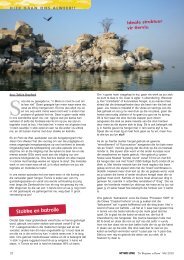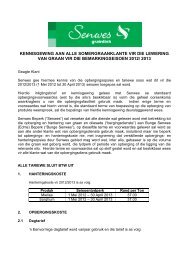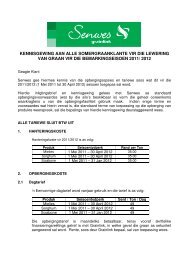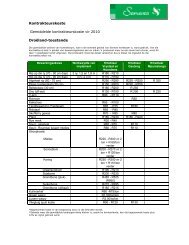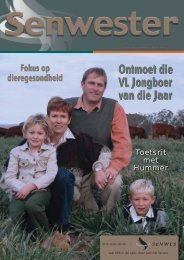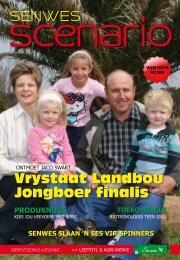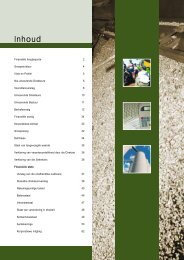Create successful ePaper yourself
Turn your PDF publications into a flip-book with our unique Google optimized e-Paper software.
ecord the soil features that have a<br />
direct effect on the soil-profile-waterholding<br />
characteristics and link the<strong>se</strong><br />
features to the crop’s respon<strong>se</strong> to climatic<br />
factors such as:<br />
• rainfall (distribution instead of <strong>se</strong>ason<br />
total),<br />
• energy (temperature and heat<br />
units) as well as<br />
• atmospheric evaporative demand<br />
(evapo-transpiration).<br />
By doing this, it is possible to quantify<br />
the expected yield respon<strong>se</strong> for a<br />
soil characteristic, e.g. effective depth<br />
for different areas. This is shown in<br />
Figure 2.<br />
When incorporating weather data<br />
in the yield potential calculations, the<br />
effect of rainfall distribution is clearly<br />
identified. Generally it is possible to<br />
identify three types of <strong>se</strong>asons:<br />
• a very good <strong>se</strong>ason where rainfall<br />
distribution as well as quantity is<br />
very favourable for maize growth,<br />
• a good <strong>se</strong>ason where there is sufficient<br />
rain, but distribution is poor,<br />
and then<br />
• a poor <strong>se</strong>ason where rainfall is<br />
either just low or there is a <strong>se</strong>vere<br />
midsummer drought.<br />
This effect is shown in Figure 3 for<br />
simulated yield respon<strong>se</strong>s done for<br />
soil and climate data from the Bethal<br />
district.<br />
Although this technique was initiated<br />
in South Africa and the first work<br />
done only in 2003, excellent agreement<br />
between predicted and actual<br />
results have been obtained where it<br />
has been possible to do comparisons<br />
with field trials or yield monitor data.<br />
Where differences have been identified,<br />
this has been as a result of either<br />
nutrient deficiencies or another overriding<br />
yield limiting factor.<br />
Enquiries<br />
If you require any further information<br />
about soil as<strong>se</strong>ssments plea<strong>se</strong> contact<br />
Dr Neil du Sautoy at Senwes<br />
Agricultural Services on 082 419 0949<br />
or (018) 464-7391 or <strong>se</strong>nd an e-mail<br />
to neil.dusautoy@<strong>se</strong>nwes.co.za.<br />
At pre<strong>se</strong>nt Senwes Agricultural<br />
Services is implementing this approach<br />
to soil potential as<strong>se</strong>ssments<br />
and building up its databa<strong>se</strong>. We<br />
would therefore appreciate the cooperation<br />
of anybody who has yield<br />
monitor data that could be u<strong>se</strong>d.<br />
landbou in praktyk<br />
Figure 2: Simulated yield potential increa<strong>se</strong>s with increa<strong>se</strong> in root depth for two<br />
districts.<br />
Figure 3: Simulated yield potential increa<strong>se</strong>s with increa<strong>se</strong> in root depth for three<br />
<strong>se</strong>ason types in the Bethal district. Percentage values are the frequency of occurrence<br />
for a specific type of <strong>se</strong>ason.<br />
The effect of rainfall distribution has a great effect on yield potential calculations.<br />
39






